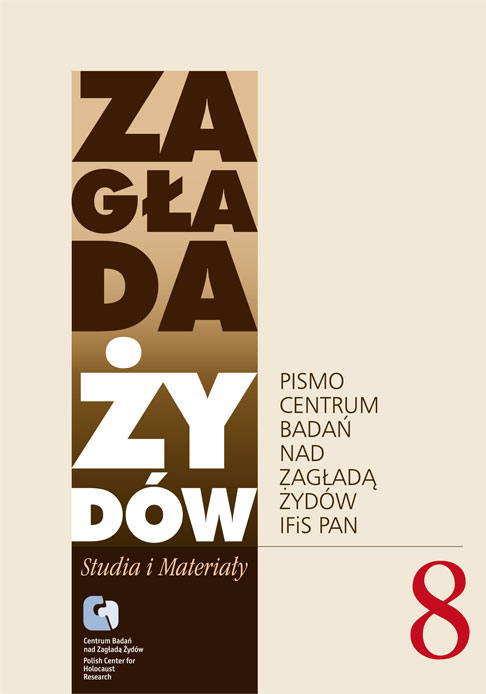Odmienne sylwetki przybyłych do Szwecji więźniów pochodzenia żydowskiego i nieżydowskiego, ocalałych z obozów koncentracyjnych na ziemiach polskich
Zagłada Żydów. Studia i Materiały, Nr 8 (2012), Strony: 419-429
Data zgłoszenia: 2020-12-06Data publikacji: 2012-12-02
 https://doi.org/10.32927/zzsim.698
https://doi.org/10.32927/zzsim.698
Abstrakt
Survivors from Nazi concentration camps, who were brought to Sweden as refugees during the last month of the Second World War and during the summer that followed, were often required to supply information about personal details to the authorities. Much of the information was later stored in written form in the Swedish National Archives. Antisemitism among the refugees and enmity between the Jewish and non-Jewish Polish refugees caused the authorities to include their ethnic or religious affiliation in many records and documents. Using mainly two collections from the Swedish National Archives it is shown that substantial differences existed between Jewish and non-Jewish Polish refugees with respect to their age, education and the length of their war experiences. These differences, in addition to the existing socio-geographic, demographic, cultural and ethnic differences led to inevitable clashes between the two groups. The Swedish authorities who first regarded all refugees of Polish citizenship as one national group had to revise this attitude gradually during the administration of the refugees
Słowa kluczowe
ocalali z Zagłady , Szwecja , stosunki polsko-żydowskie
Licencja
Prawa autorskie (c) 2012 Autor&"Zagłada Żydów. Studia i Materiały"

Utwór dostępny jest na licencji Creative Commons Uznanie autorstwa 4.0 Międzynarodowe.
https://creativecommons.org/licenses/by/4.0
Czasopismo publikowane jest w standardzie Diamond Open Access na licencji CC-BY-4.0 Deed - Uznanie autorstwa 4.0 Międzynarodowa - Creative Commons
Podobne artykuły
- Krzysztof Persak, Wydmuszka. Lektura krytyczna Miast śmierci Mirosława Tryczyka , Zagłada Żydów. Studia i Materiały: Nr 12 (2016)
- Karolina Panz, „Dlaczego oni, którzy tyle przecierpieli i przetrzymali, musieli zginąć”. Żydowskie ofiary zbrojnej przemocy na Podhalu w latach 1945–1947 , Zagłada Żydów. Studia i Materiały: Nr 11 (2015)
- Roman Romantsov, Od radzieckiej amnezji do ukraińskiej (nie)pamięci. Zagłada w pamięci kulturowej Ukrainy 1991–2017 , Zagłada Żydów. Studia i Materiały: Nr 14 (2018)
- Andrzej Grzegorczyk, Dieter Schenk, Witold Kulesza, Arthur Greiser. Biografia i proces namiestnika III Rzeszy w Kraju Warty , Zagłada Żydów. Studia i Materiały: Nr 20 (2024)
- Karolina Panz, Małgorzata Melchior, Nechama Tec , Zagłada Żydów. Studia i Materiały: Nr 19 (2023)
- Tadeusz Bartoś, Zapomnieć , Zagłada Żydów. Studia i Materiały: Nr 11 (2015)
- Antoni Sułek, Lament nad Izbicą: Rafał Hetman, Izbica, Izbica [Antoni Sułek] , Zagłada Żydów. Studia i Materiały: Nr 17 (2021)
- Małgorzata Preuss, ARCHITEKCI ZAGŁADY – analiza funkcjonowania Centralnego Zarządu Budowlanego w KL Auschwitz-Birkenau , Zagłada Żydów. Studia i Materiały: Nr 2 (2006)
- Krzysztof Persak, Co dziś wiemy o niemieckich represjach za pomoc udzielaną Żydom? O książce Represje za pomoc Żydom na okupowanych ziemiach polskich w czasie II wojny światowej , Zagłada Żydów. Studia i Materiały: Nr 16 (2020)
- Alina Skibinska, Życie codzienne Żydów w Kozienicach pod niemiecką okupacją , Zagłada Żydów. Studia i Materiały: Nr 3 (2007)
<< < 1 2 3 4 5 6 7 8 9 10 11 12 13 14 15 16 17 18 19 20 21 22 23 24 25 26 27 28 29 30 31 32 33 34 35 36 37 38 39 40 41 42 43 44 45 46 47 48 49 50 > >>
Możesz również Rozpocznij zaawansowane wyszukiwanie podobieństw dla tego artykułu.
 English
English
 Język Polski
Język Polski




